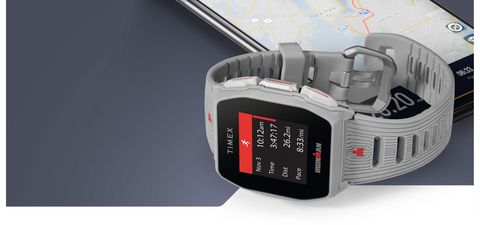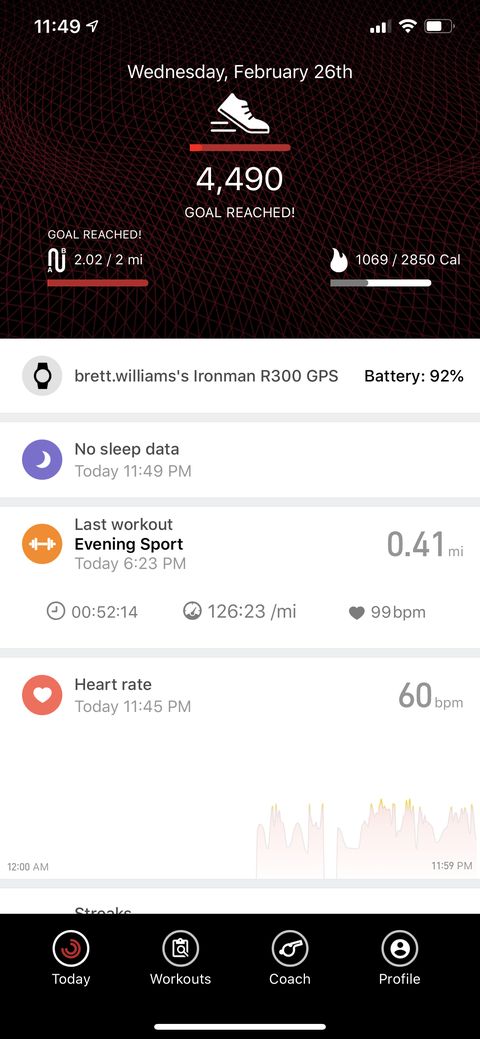When some people strap on a smartwatch, they expect a fully-fledged mini-computer for their wrist. Today’s highest profile gadgets have apps, on-device payments, LTE capabilities, and more—which can make wearing and using one feel like a chore, with layers of menus and complex commands to start tasks like tracking a workout.
But if you’re a super dedicated athlete, you’re probably focused on just one thing: your performance. When you’re training, you don’t need to ask your watch’s built-in digital assistant to answer questions; you need your up-to-the-moment data, and you need it without an overblown command path. On the other side of the scale, there are guys who want a solid tracker for more casual use without all the fuss—or importantly, the expense—that comes with overpowered wearables.
Timex’s new smartwatch, the Ironman GPS R300, is a solid choice for both demographics. The R300 looks to cut through smartwatch feature bloat and give the most dedicated athletes exactly what they need from a wearable—and nothing else. That type of focus is also ideal for those who value simple functionality above all, even if all they want to do is check the time and count their steps.
The watch has an optical heart rate monitor, onboard GPS, and, most importantly for die-hard weekend warriors, an estimated 25 days of battery life (20 hours of GPS mode). And at $120, the R300 is comfortably less expensive than its closest competitors, many of which start at $150 for much less power and fewer features.
I had a chance to take the Ironman GPS R300 for a spin ahead of its release today and was impressed with its simple, reliable interface and truly remarkable battery.

Timex Ironman R300 GPS Watch
timex.com
$120.00
SHOP NOW
The R300, which looks similar to the brand’s GPS watch, is a rough-and-tumble device clearly made to take a beating. The pliable silicone band and hard plastic casing feel like a standard runner’s timepiece, but the responsive touchscreen is a class above that of a run-of-the-mill lap timer. Like other smartwatches, you can use the screen to change the device’s face, swipe through different commands, and view all of your relevant training data. Like other smartwatches, you’ll receive notifications from your phone, and you can also control the music from your phone’s player. But unlike many other smartwatches, the R300 largely sticks to what it does best: activity tracking.
The watch’s interface is responsive on the road. All it takes is three quick button taps to start a running workout (other workout modes include cycling, treadmill, indoor cycling, walking, and ‘any sport,’ a catchall category for gym workouts). My initial test unit had some issues connecting with the GPS, but that was smoothed over with a replacement device. The run tracking is a breeze to use—the always-on display clearly displays pace, mileage, and time spent during the workout. There’s also an accurate auto-pause feature, too, something I’ve had trouble with on more expensive wearables in the past. The optical heart rate monitor works well; its readings were in line with those of one of my preferred wrist-based monitor, the WHOOP strap (the Apple Watch being the other), when I put a live reading to the test.

Timex’s connected app, the Timex Smart, is also surprisingly accessible and robust. There, you can review your workout data, check in on your sleep, and even select workouts to add to the watch. The simple layout made it easy to adjust the watch’s settings, too (you’ll probably want to mute its many beeps).
But the most impressive thing about the R300 is what makes it most attractive to both power users and casual technophobes who can’t keep track of more than one cord at a time: the battery. I tested the device for over two weeks and the power level didn’t even dip below 50 percent. Serious athletes who depend on GPS tracking to eat up trail might not get quite that much juice out of the watch, but it’s still a far better situation than using devices that need weekly or, more likely, daily charging.
Techies and hardcore adventurers will still need more from a smartwatch than the R300 can provide—and there’s nothing wrong with that. High-powered wearables can be incredibly cool and useful, and I love using them. But there’s also room on the opposite end of the spectrum when all of the features feel like too much.
The Timex Ironman GPS R300 stood out to me at the outset of my testing as a device that might be caught between categories—it was either a really smart dumbwatch, or a dumber-than-average smartwatch. After putting the watch through its paces, I think I know where it actually belongs: On the wrists of people who don’t want their gadgets to overshadow what they’re trying to do.

Men’s Health
Men’s Health Subscription
SHOP NOW
Source: Read Full Article
